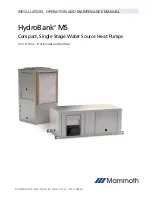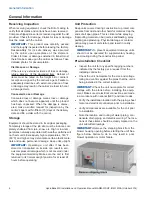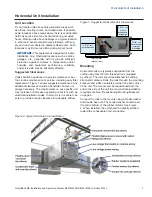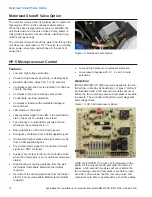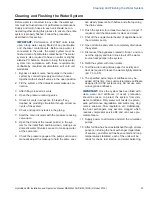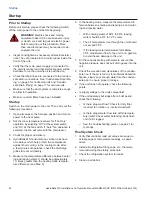
HydroBank MS Installation and Operation Manual MAMM-WSHP-IOM-1MSA (October 2014)
9
Horizontal Unit Installation
No heat pump should be connected to the supply and
return piping until the water system has been cleaned and
flushed completely. See”Cleaning and Flushing the Water
System” on page 23.
Check for proper water balance by measuring the differen-
tial temperature reading across the water connections. To
ensure proper water flow, it should be between 10°F and
14°F for heat pumps in the cooling mode.
Condensate Drain Piping
A flush-mounted drain connection is provided on the out-
side of horizontal cabinets, on the end opposite the water
line connections. Condensate piping can be PVC, steel or
copper. PVC typically eliminates the need to insulate the
pipe to prevent sweating.
A condensate trap that has a depth of at least 3 inches
or 2.5 times the expected negative static pressure of the
unit must be provided. The condensate pipe run must
slope away from all units at least 1/8 inch per foot. The
trap may be constructed of PVC, copper or steel. Piping
should be vented, with the vent after the trap. See Fig-
ure 5 below for an example. Refer to local codes for the
correct condensate piping to drains.
Figure 5: Vented PVC Condensate Trap by Others
Ductwork and Sound Attenuation
Horizontal, ceiling-mounted heat pumps virtually always
have discharge ductwork attached to the unit. A collar
is provided on the discharge to facilitate attachment to
the ductwork. Ductwork should conform to industry stan-
dards. See Figure 6 below and “Discharge Duct Sizing
Considerations” on page 12.
Good design practice requires a flexible connector
between the collar and transition to the main duct sys-
tem. This connector attenuates sound from the unit,
especially fan sound, and simplifies unit removal.
Ductwork should be lined with an acoustic, thermal insu-
lation that is a minimum of ½ inch thick. For sensitive
installations, use 1-inch insulation a minimum of five to
10 feet prior to each diffuser. For applications that are
especially acoustically sensitive, consider an acoustic kit
that includes additional unit lining and dampening mate-
rial beneath the entire unit.
Ducted returns may be used on horizontal units for
acoustically sensitive applications. Return ducting
should extend at least 12 inches from the coil before
transitioning to provide even air distribution across the
coil. A flexible connector should be used to connect the
unit to the return ducting to attenuate unit sound levels
and allow ease of unit removal. The filter section is sup-
plied with a bracket to accommodate return ductwork.
Changes in duct direction and internal devices such as
dampers that create airflow turbulence can increase
acoustic problems. Minimize these items where pos-
sible. Placing a straight run of duct between fittings will
decrease turbulence and associated noise. Diffusers
located in the bottom of a trunk duct pose acoustical
problems. Volume control dampers should be placed well
upstream of any air outlets.
Figure 6: ASHRAE AND SMACNA Suggested Supply and Return Air Ducting
Flexible connectors
Ductwork supported
independently from unit
Return air located
away from unit fan
Acoustic
thermal lining
Two 90 degree turns
prior to intake

